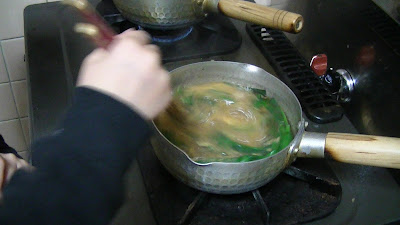 |
| Plum blossoms washed by a morning rain... |
The plum blossoms are most of the way out--my favorite of the flowering trees because of their elegant, faintly cinnamon scent.
 |
| White plum and lichen... |
...this morning I had to wait 'til the rain stopped before going to take a couple of pictures of my favorite weeping plums up the road...
 |
| bonsai.. |
...taking a detour on the way home, I discovered that one of the neighbors had a lovely weeping plum bonsai out front (beside which a pair of cats sat growling at one another, for what reason I was at a loss to understand)...
But, as I mentioned last week, Mr. Harris who lives up in Tokyo invited us to visit a beautiful park filled with plum trees near his home. So, after some checking of optimal viewing days and scheduling around baseball games and such, we took the Keio Line to Mogusaen--a park named "Hundred Blossom Park".
 |
| the entrance to Mogusaen |
This park is situated on a steep hillside--infinitely more enchanting than the flat, spread out "park" I had imagined, and well-suited, somehow, to displaying the plum trees.
...stone steps and narrow, twisting paths that echo the fantastically twisting branches of the trees...
 |
| plum blossoms and blue sky |
In spite of snow two days earlier and rain the day before, we were lucky to have a gorgeous bright blue day on Sunday...

...I notice that I keep taking the same picture;-)) Bright pink blossoms against a brilliant blue winter sky...
This particular tree is a good example of the severe pruning plum trees are subjected to in order to achieve those curling shapes...
 |
| Roubai...Wintersweet...Chimonanthus praecox |
As a matter of fact, Mogusaen has quite a variety of trees and flowers, though the ume are the main draw. At the top of the stone steps at the entrance, I was attracted to a small tree with interesting waxy yellow flowers that I've seen elsewhere without knowing what they were called (I just can't stand not knowing what things are called...). It's called "Roubai", literally "Wax Plum", and it has a heavenly sweet scent. My mother-in-law has some in her garden, and often has a bouquet of the branches in a large vase in her genkan, which makes the whole genkan smell wonderful...
A great many of the plum trees in the park are very old, so the larger branches have wooden supports lashed in place with rope beneath the cantilevered branches...
...like this tree--so old, that half the trunk had rotted away. This one, too, had several supports under branches that were too heavy, as well as under the main trunk--hollowed out, covered in a thick layer of moss, twisted like a moebius strip...
They had an unusual winter-blooming iris as well. It's name in Japanese was, appropriately, "Kanzakiayame",
(pictured below)
 |
| Iris unguicularis |
...which means simply "Cold Blooming Iris". It reminded me a little of the beautiful purple bearded irises my mom grew in Indiana. I wonder if I'll be able to surprise my mother with this one..?
If the winter iris doesn't do it, the vining pine trees surely will. Japanese gardeners can get any plant to do anything they want--they can even, with various clever tricks, make a pine tree grow like a morning glory. A sturdy pole and an umbrella of neatly tied off ropes, and voila! ...a vining pine tree...
 |
| Adonis ramosa...Pheasant's eye |
In the center of the garden, under the oldest and biggest tree in the park were blooming cheerful yellow flowers I'd never seen before: Fukujusou, whose name is composed of the kanji 福 ( fuku: fortune, blessing, prosperity, happiness, wealth), and 寿 (ju: longevity, celebration, felicitation). I certainly felt fortunate to see golden flowers blooming on a cold day in February...;-))
Fortunate, indeed--there was even a hybrid bonsai ume with special bi-color blossoms that everybody was taking pictures of. Kawaii desu, ne!
But by far the most amazing thing in the park was the gigantic ancient plum tree in the center...
 |
| click to enlarge |
...words fail me to describe this tree, and photos nearly fail at the job as well...
If this licorice-twisted branch didn't grow this way naturally, how was this accomplished? By horticulturalists who moonlight as shamans?
...pale, delicate blossoms grace moss-covered curves...
 |
| Prunus mume |
I hold no supernatural beliefs--but gazing for any length of time at a tree this gnarled, this mossy, this contorted , you expect elves...or gnomes...or Totoro at least to step out of the base and give you a wink.

...It was nearly time to go. That is, everybody else was ready to go home. Except for mama--who had to tear herself away from pink-and-white cinnamon-scented blossoms ("you don't *really* need dinner, do you?")...
 |
| Looking down on the park from the top of the hill... |
|

...Kohaku-- white against red...

...the darkest pink-red blossoms in the park...
...the Main Gate--made of bamboo, held together with ropes and moss and ferns...
Even the train station was decorated with plum branches...
 |
| Mogusaen-- Sayonara... |






















































